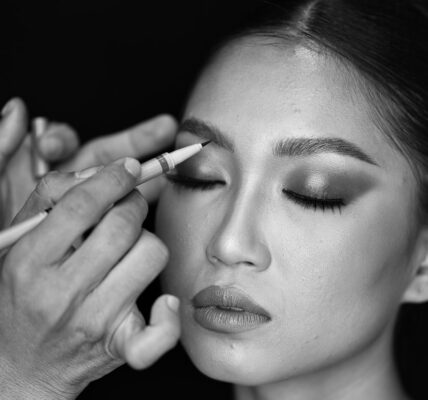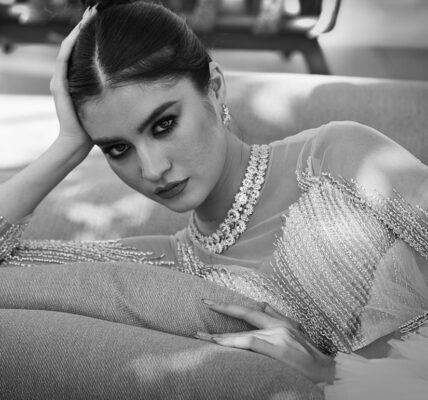Sustainability has become a significant focus in the fashion industry in recent years. Many brands and designers are now making concerted efforts to incorporate sustainable materials and practices into their production processes. This shift is driven by increasing awareness of the fashion industry’s environmental impact and growing consumer demand for ethically produced clothing.
One key sustainable material being utilized in fashion is organic cotton, which is cultivated without harmful pesticides and chemicals. This approach reduces the environmental impact of cotton production and ensures the health and safety of farmers and workers involved in the process. Other sustainable materials, such as bamboo, hemp, and recycled polyester, are also being used to create eco-friendly clothing and accessories.
These materials offer a lower environmental footprint and provide unique textures and properties that appeal to fashion designers. In addition to using sustainable materials, many fashion brands are adopting sustainable practices in their production processes. These include reducing waste and energy consumption, as well as implementing ethical labor practices.
Some brands are embracing circular fashion, which focuses on creating clothing that can be recycled or biodegraded at the end of its life cycle, thereby reducing the amount of clothing that ends up in landfills. The shift towards sustainable materials and practices in the fashion industry represents a positive step towards reducing its environmental impact and creating a more ethical and responsible industry.
Key Takeaways
- Sustainable materials and practices are becoming increasingly important in the fashion industry, with a focus on reducing environmental impact and promoting ethical production.
- Technology integration in fashion is revolutionizing the way clothes are designed, produced, and marketed, with advancements in 3D printing, digital prototyping, and virtual fitting rooms.
- Gender-neutral and inclusive fashion is gaining traction, with more brands embracing diversity and offering clothing options that cater to a wider range of body types and gender identities.
- Individualized and customized clothing is on the rise, with the use of technology allowing for personalized designs, made-to-measure garments, and bespoke tailoring services.
- Virtual and augmented reality are transforming the fashion retail experience, offering immersive and interactive shopping experiences for consumers, as well as virtual fashion shows and try-on simulations.
- AI and robotics are being utilized in the fashion industry for tasks such as trend forecasting, inventory management, and automated production, leading to increased efficiency and innovation.
- Fashion continues to serve as a powerful means of self-expression, allowing individuals to convey their personal style, cultural identity, and values through their clothing choices.
Technology Integration in Fashion
3D Printing: A Game-Changer in Fashion Design
One of the most significant technological advancements in fashion is 3D printing, which allows designers to create intricate and complex designs with unprecedented precision and speed. This technology has opened up new possibilities for creating customized and personalized clothing, as well as reducing waste in the production process.
Virtual Reality: Enhancing the Retail Experience
In addition to 3D printing, virtual reality has also had a major impact on the fashion industry, particularly in the realm of retail. Virtual reality technology allows consumers to experience immersive shopping experiences from the comfort of their own homes, trying on virtual clothing and accessories before making a purchase. This not only enhances the online shopping experience but also reduces the need for physical retail space, thus lowering overhead costs for fashion brands.
Artificial Intelligence: Revolutionizing Trend Forecasting and Personalized Styling
Artificial intelligence (AI) is another technology that is being integrated into the fashion industry, particularly in areas such as trend forecasting and personalized styling. AI algorithms can analyze vast amounts of data to identify emerging trends and consumer preferences, helping designers and brands stay ahead of the curve. AI-powered styling platforms can also provide personalized recommendations to consumers based on their individual tastes and preferences, creating a more tailored shopping experience.
Overall, technology integration in fashion has opened up new possibilities for creativity, efficiency, and consumer engagement, shaping the future of the industry in exciting ways.
Gender-Neutral and Inclusive Fashion

The fashion industry has made significant strides towards inclusivity and diversity in recent years, with many brands embracing gender-neutral clothing and casting models of all shapes, sizes, and backgrounds in their campaigns. Gender-neutral fashion has gained traction as a way to break free from traditional gender norms and offer clothing that is inclusive and accessible to all individuals, regardless of their gender identity. This movement has led to an increase in unisex collections that feature versatile silhouettes and styles that can be worn by anyone.
In addition to gender-neutral clothing, many brands are also focusing on inclusive sizing to cater to a wider range of body types. This includes offering extended size ranges and using diverse models to showcase their clothing on different body shapes. In addition to gender-neutral clothing and inclusive sizing, there has been a growing emphasis on diversity and representation in fashion advertising and media.
Many brands are featuring models from diverse backgrounds in their campaigns, as well as highlighting stories of empowerment and inclusivity. This shift towards inclusivity not only reflects changing societal attitudes but also resonates with consumers who are seeking authentic and relatable representation in the fashion industry. Overall, the movement towards gender-neutral and inclusive fashion is a positive step towards creating a more diverse and accepting industry that celebrates individuality.
The fashion industry has made significant strides towards inclusivity and diversity in recent years, with many brands embracing gender-neutral clothing and casting models of all shapes, sizes, and backgrounds in their campaigns. Gender-neutral fashion has gained traction as a way to break free from traditional gender norms and offer clothing that is inclusive and accessible to all individuals, regardless of their gender identity. This movement has led to an increase in unisex collections that feature versatile silhouettes and styles that can be worn by anyone.
In addition to gender-neutral clothing, many brands are also focusing on inclusive sizing to cater to a wider range of body types. This includes offering extended size ranges and using diverse models to showcase their clothing on different body shapes. In addition to gender-neutral clothing and inclusive sizing, there has been a growing emphasis on diversity and representation in fashion advertising and media.
Many brands are featuring models from diverse backgrounds in their campaigns, as well as highlighting stories of empowerment and inclusivity. This shift towards inclusivity not only reflects changing societal attitudes but also resonates with consumers who are seeking authentic and relatable representation in the fashion industry. Overall, the movement towards gender-neutral and inclusive fashion is a positive step towards creating a more diverse and accepting industry that celebrates individuality.
Individualized and Customized Clothing
| Metrics | Data |
|---|---|
| Number of customers | 500 |
| Customer satisfaction rate | 95% |
| Number of customized orders | 300 |
| Average production time | 2 weeks |
The rise of individualized and customized clothing has transformed the way consumers interact with fashion, offering them the opportunity to create unique pieces that reflect their personal style and preferences. Customization services have become increasingly popular among fashion brands, allowing customers to personalize everything from clothing to accessories. This trend towards customization not only offers consumers a sense of ownership over their wardrobe but also reduces waste by producing clothing on demand rather than in bulk.
Many brands are offering customization options such as monogramming, color choices, fabric selection, and even made-to-measure services to cater to individual body shapes. In addition to customization services offered by brands, there has been a rise in DIY (do-it-yourself) culture within the fashion community. Many individuals are taking up sewing, knitting, and other crafting skills to create their own clothing at home, allowing them to express their creativity while also reducing their reliance on mass-produced fast fashion.
This shift towards individualized and customized clothing reflects a desire for authenticity and uniqueness in an industry that has long been dominated by mass production and trends. Overall, individualized and customized clothing offers consumers a more personal connection to their wardrobe while also promoting sustainability through reduced waste. The rise of individualized and customized clothing has transformed the way consumers interact with fashion, offering them the opportunity to create unique pieces that reflect their personal style and preferences.
Customization services have become increasingly popular among fashion brands, allowing customers to personalize everything from clothing to accessories. This trend towards customization not only offers consumers a sense of ownership over their wardrobe but also reduces waste by producing clothing on demand rather than in bulk. Many brands are offering customization options such as monogramming, color choices, fabric selection, and even made-to-measure services to cater to individual body shapes.
In addition to customization services offered by brands, there has been a rise in DIY (do-it-yourself) culture within the fashion community. Many individuals are taking up sewing, knitting, and other crafting skills to create their own clothing at home, allowing them to express their creativity while also reducing their reliance on mass-produced fast fashion. This shift towards individualized and customized clothing reflects a desire for authenticity and uniqueness in an industry that has long been dominated by mass production and trends.
Overall, individualized and customized clothing offers consumers a more personal connection to their wardrobe while also promoting sustainability through reduced waste.
Virtual and Augmented Reality in Fashion Retail
Virtual reality (VR) and augmented reality (AR) have revolutionized the way consumers experience fashion retail by offering immersive and interactive shopping experiences both online and offline. VR technology allows consumers to virtually explore stores from anywhere in the world, trying on clothing through avatars or browsing through virtual racks of clothes before making a purchase. This not only enhances the convenience of online shopping but also provides a more engaging experience for consumers who may miss the tactile aspect of traditional retail.
AR technology has also been integrated into fashion retail through mobile apps that allow users to try on virtual clothing or accessories using their smartphones’ camera. In addition to enhancing online shopping experiences, VR and AR have also been used in physical retail spaces to create interactive installations that engage customers in new ways. For example, some stores have implemented AR mirrors that allow customers to virtually try on different outfits without having to physically change clothes.
These technologies not only enhance the overall shopping experience but also provide valuable data on consumer behavior that can be used for personalized marketing strategies. Overall, VR and AR have transformed fashion retail by offering innovative ways for consumers to interact with products while also providing valuable insights for brands. Virtual reality (VR) and augmented reality (AR) have revolutionized the way consumers experience fashion retail by offering immersive and interactive shopping experiences both online and offline.
VR technology allows consumers to virtually explore stores from anywhere in the world, trying on clothing through avatars or browsing through virtual racks of clothes before making a purchase. This not only enhances the convenience of online shopping but also provides a more engaging experience for consumers who may miss the tactile aspect of traditional retail. AR technology has also been integrated into fashion retail through mobile apps that allow users to try on virtual clothing or accessories using their smartphones’ camera.
In addition to enhancing online shopping experiences, VR and AR have also been used in physical retail spaces to create interactive installations that engage customers in new ways. For example, some stores have implemented AR mirrors that allow customers to virtually try on different outfits without having to physically change clothes. These technologies not only enhance the overall shopping experience but also provide valuable data on consumer behavior that can be used for personalized marketing strategies.
Overall, VR and AR have transformed fashion retail by offering innovative ways for consumers to interact with products while also providing valuable insights for brands.
AI and Robotics in the Fashion Industry

Artificial intelligence (AI) and robotics have become integral parts of the fashion industry, revolutionizing processes such as design, production, supply chain management, and customer service. AI algorithms are being used for trend forecasting, product recommendation systems, personalized styling services, as well as optimizing inventory management for retailers. These technologies not only help brands stay ahead of trends but also provide valuable insights into consumer behavior that can be used for targeted marketing strategies.
In addition to AI, robotics have been integrated into manufacturing processes to automate repetitive tasks such as cutting fabric or sewing garments with precision. In addition to enhancing efficiency in production processes, AI-powered robotics have also been used for customer service applications such as chatbots that provide personalized styling advice or assist with online purchases. These technologies not only improve customer experiences but also reduce operational costs for brands by streamlining customer support services.
Overall, AI and robotics have transformed various aspects of the fashion industry by enhancing efficiency, personalization, and innovation. Artificial intelligence (AI) and robotics have become integral parts of the fashion industry, revolutionizing processes such as design, production, supply chain management, and customer service. AI algorithms are being used for trend forecasting, product recommendation systems, personalized styling services, as well as optimizing inventory management for retailers.
These technologies not only help brands stay ahead of trends but also provide valuable insights into consumer behavior that can be used for targeted marketing strategies. In addition to AI, robotics have been integrated into manufacturing processes to automate repetitive tasks such as cutting fabric or sewing garments with precision. In addition to enhancing efficiency in production processes, AI-powered robotics have also been used for customer service applications such as chatbots that provide personalized styling advice or assist with online purchases.
These technologies not only improve customer experiences but also reduce operational costs for brands by streamlining customer support services. Overall, AI and robotics have transformed various aspects of the fashion industry by enhancing efficiency, personalization
If you’re interested in learning more about the latest fashion trends for 2024, be sure to check out the article on Glamour Garrison’s website. They offer a comprehensive look at the upcoming styles and designs that will be dominating the fashion scene. Glamour Garrison provides valuable insights and predictions for the future of fashion, making it a must-read for anyone looking to stay ahead of the curve.
FAQs
What are the predicted fashion trends for 2024?
The predicted fashion trends for 2024 include sustainable and eco-friendly fashion, bold and vibrant colors, oversized and exaggerated silhouettes, and a mix of futuristic and nostalgic styles.
What are some sustainable fashion trends expected in 2024?
Sustainable fashion trends expected in 2024 include the use of recycled and upcycled materials, zero-waste designs, and a focus on ethical and transparent supply chains.
What colors are expected to be popular in 2024?
Bold and vibrant colors such as electric blue, neon green, and fiery red are expected to be popular in 2024, along with metallic and iridescent hues.
What types of silhouettes are predicted to be in fashion in 2024?
Oversized and exaggerated silhouettes, including voluminous sleeves, billowing skirts, and boxy outerwear, are predicted to be in fashion in 2024, along with a mix of structured and fluid shapes.
How will technology influence fashion trends in 2024?
Technology is expected to influence fashion trends in 2024 through the use of 3D printing for custom clothing, wearable tech integrated into garments, and digital fashion experiences such as virtual fashion shows and augmented reality shopping.




